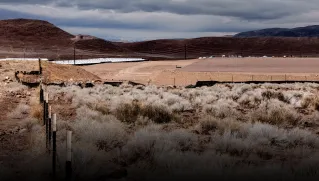In the high desert east of Reno, Nevada, construction crews are flattening the golden foothills of the Virginia Range, laying the foundations of a data center city.
Google, Tract, Switch, EdgeCore, Novva, Vantage, and PowerHouse are all operating, building, or expanding huge facilities within the Tahoe Reno Industrial Center, a business park bigger than the city of Detroit.
This story is a part of MIT Technology Review’s series “Power Hungry: AI and our energy future,” on the energy demands and carbon costs of the artificial-intelligence revolution.
Meanwhile, Microsoft acquired more than 225 acres of undeveloped property within the center and an even larger plot in nearby Silver Springs, Nevada. Apple is expanding its data center, located just across the Truckee River from the industrial park. OpenAI has said it’s considering building a data center in Nevada as well.
The corporate race to amass computing resources to train and run artificial intelligence models and store information in the cloud has sparked a data center boom in the desert—just far enough away from Nevada’s communities to elude wide notice and, some fear, adequate scrutiny.

The full scale and potential environmental impacts of the developments aren’t known, because the footprint, energy needs, and water requirements are often closely guarded corporate secrets. Most of the companies didn’t respond to inquiries from MIT Technology Review, or declined to provide additional information about the projects.
But there’s “a whole lot of construction going on,” says Kris Thompson, who served as the longtime project manager for the industrial center before stepping down late last year. “The last number I heard was 13 million square feet under construction right now, which is massive.”
Indeed, it’s the equivalent of almost five Empire State Buildings laid out flat. In addition, public filings from NV Energy, the state’s near-monopoly utility, reveal that a dozen data-center projects, mostly in this area, have requested nearly six gigawatts of electricity capacity within the next decade.
That would make the greater Reno area—the biggest little city in the world—one of the largest data-center markets around the globe.
It would also require expanding the state’s power sector by about 40%, all for a single industry in an explosive growth stage that may, or may not, prove sustainable. The energy needs, in turn, suggest those projects could consume billions of gallons of water per year, according to an analysis conducted for this story.

The build-out of a dense cluster of energy and water-hungry data centers in a small stretch of the nation’s driest state, where climate change is driving up temperatures faster than anywhere else in the country, has begun to raise alarms among water experts, environmental groups, and residents. That includes members of the Pyramid Lake Paiute Tribe, whose namesake water body lies within their reservation and marks the end point of the Truckee River, the region’s main source of water.
Much of Nevada has suffered through severe drought conditions for years, farmers and communities are drawing down many of the state’s groundwater reservoirs faster than they can be refilled, and global warming is sucking more and more moisture out of the region’s streams, shrubs, and soils.
“Telling entities that they can come in and stick more straws in the ground for data centers is raising a lot of questions about sound management,” says Kyle Roerink, executive director of the Great Basin Water Network, a nonprofit that works to protect water resources throughout Nevada and Utah.
“We just don’t want to be in a situation where the tail is wagging the dog,” he later added, “where this demand for data centers is driving water policy.”
Luring data centers
In the late 1850s, the mountains southeast of Reno began enticing prospectors from across the country, who hoped to strike silver or gold in the famed Comstock Lode. But Storey County had few residents or economic prospects by the late 1990s, around the time when Don Roger Norman, a media-shy real estate speculator, spotted a new opportunity in the sagebrush-covered hills.
He began buying up tens of thousands of acres of land for tens of millions of dollars and lining up development approvals to lure industrial projects to what became the Tahoe Reno Industrial Center. His partners included Lance Gilman, a cowboy-hat-wearing real estate broker, who later bought the nearby Mustang Ranch brothel and won a seat as a county commissioner.
In 1999, the county passed an ordinance that preapproves companies to develop most types of commercial and industrial projects across the business park, cutting months to years off the development process. That helped cinch deals with a flock of tenants looking to build big projects fast, including Walmart, Tesla, and Redwood Materials. Now the promise of fast permits is helping to draw data centers by the gigawatt.
On a clear, cool January afternoon, Brian Armon, a commercial real estate broker who leads the industrial practices group at NAI Alliance, takes me on a tour of the projects around the region, which mostly entails driving around the business center.

After pulling off Interstate 80 onto USA Parkway, he points out the cranes, earthmovers, and riprap foundations, where a variety of data centers are under construction. Deeper into the industrial park, Armon pulls up near Switch’s long, low, arched-roof facility, which sits on a terrace above cement walls and security gates. The Las Vegas–based company says the first phase of its data center campus encompasses more than a million square feet, and that the full build-out will cover seven times that space.
Over the next hill, we turn around in Google’s parking lot. Cranes, tents, framing, and construction equipment extend behind the company’s existing data center, filling much of the 1,210-acre lot that the search engine giant acquired in 2017.
Last August, during an event at the University of Nevada, Reno, the company announced it would spend $400 million to expand the data center campus along with another one in Las Vegas.
Thompson says that the development company, Tahoe Reno Industrial LLC, has now sold off every parcel of developable land within the park (although several lots are available for resale following the failed gamble of one crypto tenant).
When I ask Armon what’s attracting all the data centers here, he starts with the fast approvals but cites a list of other lures as well: The inexpensive land. NV Energy’s willingness to strike deals to supply relatively low-cost electricity. Cool nighttime and winter temperatures, as far as American deserts go, which reduce the energy and water needs. The proximity to tech hubs such as Silicon Valley, which cuts latency for applications in which milliseconds matter. And the lack of natural disasters that could shut down the facilities, at least for the most part.
“We are high in seismic activity,” he says. “But everything else is good. We’re not going to have a tornado or flood or a devastating wildfire.”
Then there’s the generous tax policies.

Nevada doesn’t charge corporate income tax, and it has also enacted deep tax cuts specifically for data centers that set up shop in the state. That includes abatements of up to 75% on property tax for a decade or two—and nearly as much of a bargain on the sales and use taxes applied to equipment purchased for the facilities.
Data centers don’t require many permanent workers to run the operations, but the projects have created thousands of construction jobs. They’re also helping to diversify the region’s economy beyond casinos and generating tax windfalls for the state, counties, and cities, says Jeff Sutich, executive director of the Northern Nevada Development Authority. Indeed, just three data-center projects, developed by Apple, Google, and Vantage, will produce nearly half a billion dollars in tax revenue for Nevada, even with those generous abatements, according to the Nevada Governor’s Office of Economic Development.
The question is whether the benefits of data centers are worth the tradeoffs for Nevadans, given the public health costs, greenhouse-gas emissions, energy demands, and water strains.
The rain shadow
The Sierra Nevada’s granite peaks trace the eastern edge of California, forcing Pacific Ocean winds to rise and cool. That converts water vapor in the air into the rain and snow that fill the range’s tributaries, rivers, and lakes.
But the same meteorological phenomenon casts a rain shadow over much of neighboring Nevada, forming an arid expanse known as the Great Basin Desert. The state receives about 10 inches of precipitation a year, about a third of the national average.
The Truckee River draws from the melting Sierra snowpack at the edge of Lake Tahoe, cascades down the range, and snakes through the flatlands of Reno and Sparks. It forks at the Derby Dam, a Reclamation Act project a few miles from the Tahoe Reno Industrial Center, which diverts water to a farming region further east while allowing the rest to continue north toward Pyramid Lake.
Along the way, an engineered system of reservoirs, canals, and treatment plants divert, store, and release water from the river, supplying businesses, cities, towns, and native tribes across the region. But Nevada’s population and economy are expanding, creating more demands on these resources even as they become more constrained.

Throughout much of the 2020s the state has suffered through one of the hottest and most widespread droughts on record, extending two decades of abnormally dry conditions across the American West. Some scientists fear it may constitute an emerging megadrought.
About 50% of Nevada currently faces moderate to exceptional drought conditions. In addition, more than half of the state’s hundreds of groundwater basins are already “over-appropriated,” meaning the water rights on paper exceed the levels believed to be underground.
It’s not clear if climate change will increase or decrease the state’s rainfall levels, on balance. But precipitation patterns are expected to become more erratic, whiplashing between short periods of intense rainfall and more-frequent, extended, or severe droughts.
In addition, more precipitation will fall as rain rather than snow, shortening the Sierra snow season by weeks to months over the coming decades.
“In the extreme case, at the end of the century, that’s pretty much all of winter,” says Sean McKenna, executive director of hydrologic sciences at the Desert Research Institute, a research division of the Nevada System of Higher Education.
That loss will undermine an essential function of the Sierra snowpack: reliably delivering water to farmers and cities when it’s most needed in the spring and summer, across both Nevada and California.
These shifting conditions will require the region to develop better ways to store, preserve, and recycle the water it does get, McKenna says. Northern Nevada’s cities, towns, and agencies will also need to carefully evaluate and plan for the collective impacts of continuing growth and development on the interconnected water system, particularly when it comes to water-hungry projects like data centers, he adds.
“We can’t consider each of these as a one-off, without considering that there may be tens or dozens of these in the next 15 years,” McKenna says.









